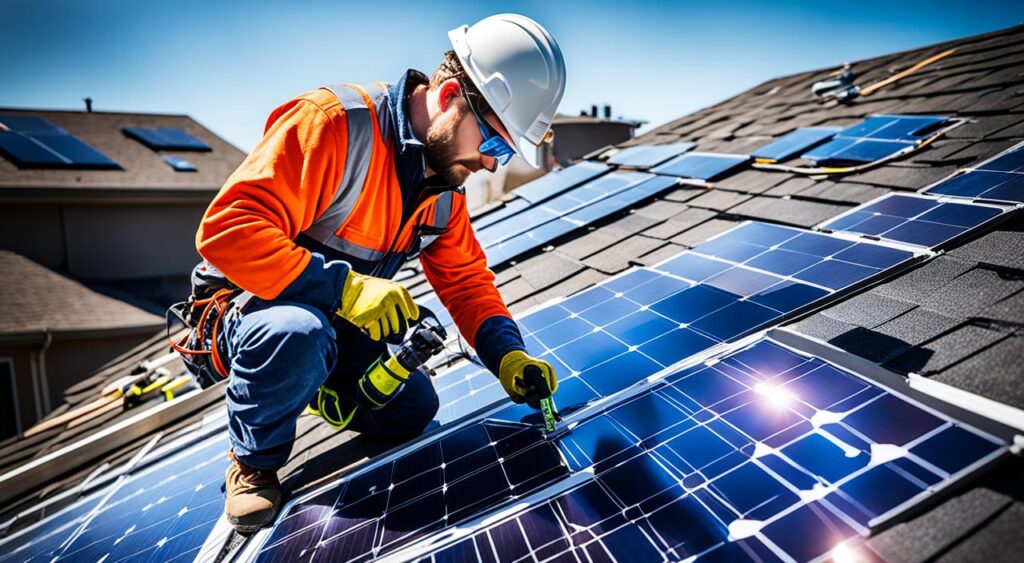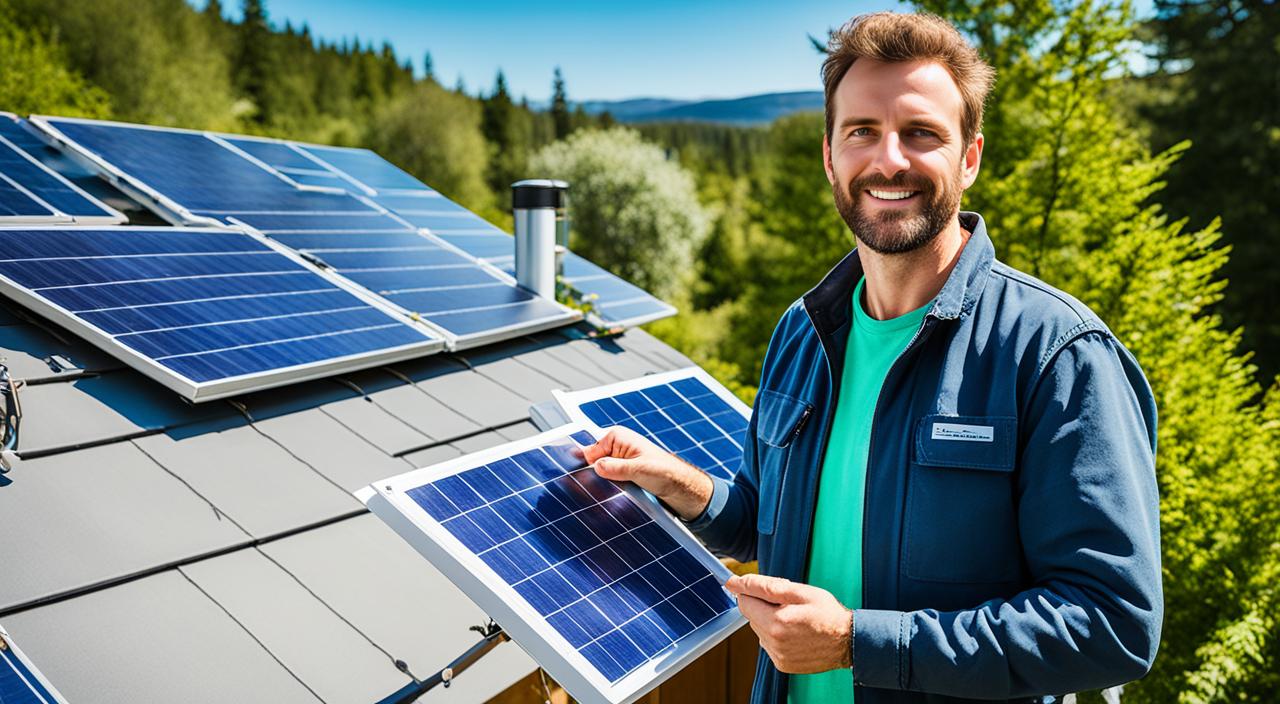DIY Solar Panels: Pros and Cons of Buying
The need for renewable energy is growing, making DIY solar panels more popular. This article will look at the good and bad of buying DIY solar panels. We aim to help you decide if solar energy is right for your home or business.
Key Takeaways
- DIY solar panels are a cheaper option compared to traditional setups, leading to savings on energy bills over time.
- Buying a DIY solar panel kit can give you a feeling of pride and independence, but you’ll need some technical skills.
- Using solar power helps the environment by cutting down on carbon emissions and supporting a greener future.
- It’s important to think about how long DIY solar panels last and the upkeep they need to work well.
- When installing DIY solar panels, check the laws in your area as they can differ, making sure you follow them.
Understanding DIY Solar Panels
In recent years, the popularity of solar power has grown a lot. This has made DIY solar panels more popular. These systems let people take control of their energy use and help the environment. They do this by installing the panels themselves, without needing professional help.
What are DIY Solar Panels?
DIY solar panels are solar power systems that you can buy and put together yourself. These kits come with everything you need, like solar cells, inverters, and mounts. This means you can install the system without needing special skills or a professional team.
The Rise of Renewable Energy
The popularity of renewable energy, especially solar power, is growing. This is because people want to be more independent with their energy and care about the planet. With solar technology getting cheaper and more efficient, more folks are looking into making their own solar power.
“The future is bright for DIY solar panels as more people seek to take control of their energy needs and reduce their carbon footprint.”
DIY solar panels let homeowners take an active role in making their own energy. This could change how we think about making and using power.

Cost-Effectiveness of DIY Solar Panels
Starting with DIY solar panels might cost more upfront than buying traditional electricity. But, the savings over time make it a smart choice. By doing it yourself, you skip the high labor costs of hiring professionals. This can save a big part of the total cost.
Initial Investment and Long-Term Savings
The initial investment in DIY solar panels is higher than usual electricity costs. Yet, the long-term savings from lower energy bills can cover this cost. Plus, the return on investment can be quite big.
- DIY solar panel installation can save you thousands in labor costs compared to professional installation.
- The long-term savings in energy costs can offset the initial investment in as little as 5-10 years, depending on your location and energy usage.
- The return on investment for DIY solar panels can be as high as 20-30% over the lifetime of the system.
“The financial benefits of DIY solar panels can be truly transformative, empowering homeowners to take control of their energy costs and contribute to a more sustainable future.”
When you look at the initial investment and the long-term savings, you can see how DIY solar panels are cost-effective. Homeowners can make a smart choice for their own situation.
Environmental Benefits of Going Solar
Switching to solar power, whether you do it yourself or hire a pro, brings many environmental benefits. Solar energy is a clean, renewable resource that doesn’t produce harmful gases or pollution. This makes it a better choice than traditional electricity from fossil fuels.
Using solar power means you use less energy from the grid. This can greatly reduce your carbon footprint. It also helps us move towards a sustainable energy future. Solar energy is key to the renewable energy movement. It’s helping us create a cleaner, greener world.
| Environmental Benefit | Impact |
|---|---|
| Reduced Carbon Emissions | Solar power doesn’t produce harmful gases, which helps lessen the environmental impact of traditional electricity. |
| Improved Air Quality | Without the need for burning fossil fuels, solar energy leads to cleaner air and less pollution. This makes the environment healthier. |
| Sustainable Resource | Solar energy is renewable and endless, providing a steady supply of clean energy for the future. |
The benefits of solar power for the environment are obvious. By choosing this sustainable and renewable energy option, we can all lower our carbon footprint. This helps create a healthier, more environmentally conscious future.
Pros and Cons of buying DIY solar panels
DIY solar panels are a great choice for homeowners looking to switch to renewable energy. But, it’s important to think about the good and bad before deciding. Let’s look at the main points for and against DIY solar panels.
Advantages of DIY Solar Panels
- Cost Savings: DIY solar panels can save you a lot of money. By doing the installation yourself, you skip the cost of hiring professionals. This means big savings on your energy bills over time.
- Energy Independence: With DIY solar panels, you can make your own clean energy. This means you’re not as tied to the traditional power grid.
- Environmental Benefits: Solar panels cut down on carbon emissions. They help make energy production cleaner and more sustainable.
Challenges of DIY Solar Panels
- Installation Complexities: Installing DIY solar panels can be hard and take a lot of time. You’ll need special knowledge and tools.
- Maintenance Requirements: Keeping your DIY solar panels working well requires regular cleaning and checks. This might be harder for homeowners than a professional setup.
- Potential Safety Risks: If not installed or maintained right, DIY solar panels can be dangerous. You could face electrical dangers or structural problems.
Deciding on DIY solar panels depends on your energy needs, budget, and how tech-savvy you are. Think about the good and bad sides to choose what’s best for you.
| Pros of DIY Solar Panels | Cons of DIY Solar Panels |
|---|---|
| Cost Savings | Installation Complexities |
| Energy Independence | Maintenance Requirements |
| Environmental Benefits | Potential Safety Risks |
Step-by-Step Guide to Installing DIY Solar Panels
Installing DIY solar panels is a great way to use renewable energy and save money. Let’s look at the main steps to get started.
Site Evaluation and Planning
First, check your site and plan the solar panel layout. Think about how much sun your area gets, the direction your roof faces, and your home’s electrical setup. This helps make sure your solar panels work their best.
Assembling the Solar Panel Kit
After planning, start putting together the solar panel kit. This includes setting up the panels, wiring them, and connecting them to your home’s power. It’s important to follow a guide and focus on safety to make sure it goes well.
Pay close attention to details and work step by step for a successful diy solar panel installation. With careful planning and a do-it-yourself attitude, you can be part of the growing group of homeowners using solar power.
Maintenance and Longevity
Investing in a DIY solar panel system can save you money on energy over time. But, you need to know how to keep it running well. Regular checks and cleanings are key to keeping your solar panels working great and lasting longer.
Routine Checks and Cleaning
To keep your DIY solar panels working well, follow these steps:
- Look over the solar panels for any damage like cracks or scratches. These can lower their performance.
- Make sure the electrical connections and wiring are tight and working right. This keeps the system safe and prevents power loss.
- Clean the solar panels often to get rid of dirt and dust. This helps more sunlight get to the cells.
- Watch the system’s power output and energy production. If you notice any changes, you might need to check or fix something.
Keeping your solar panels clean and well-maintained can make them last longer. This means they’ll keep making clean energy for you for many years.
| Maintenance Task | Frequency | Benefits |
|---|---|---|
| Visual Inspection | Quarterly | Find and fix any damage or problems |
| Electrical Check | Annually | Make sure the system is safe and works well |
| Panel Cleaning | Biannually | Keep your solar panels running at their best |
| Performance Monitoring | Continuous | Spot and fix any changes in energy production |
By spending time on regular solar panel maintenance and cleaning, your DIY solar setup will keep giving you reliable, affordable, and green energy for a long time.
Challenges and Limitations of DIY Solar Panels
DIY solar panels can save money and help the environment. But, they also have challenges and limitations. Installing them might need some technical skills, and dealing with permits and rules can be hard.
Installing DIY solar panels can be tough. You need to know about electrical systems and building methods. If you don’t have this knowledge, you might not set it up right or safely.
Also, DIY solar panels might not work as well as ones installed by pros. They might not fit your home’s specific needs, which can limit how much power they make and how well they connect to the grid.
| Challenges | Limitations |
|---|---|
|
|
Connecting DIY solar panels to the electrical grid can be tricky. You might need extra knowledge to ensure safety and follow the rules. You’ll also need to work with local authorities.
Even with challenges, homeowners can still do well with DIY solar panels. With good planning, research, and maybe getting help from experts, you can overcome these issues. This way, you can enjoy the benefits of renewable energy.
Integrating DIY Solar Panels into Your Home
Starting your DIY solar panel project means thinking about how to add these systems to your home. You have two main choices: grid-tied and off-grid solar setups. Your decision will depend on your energy use, how independent you want to be, and your home’s layout.
Grid-Tied vs. Off-Grid Systems
A grid-tied solar system connects to the local power grid. It lets you use the grid’s power when you need it and send extra energy back. This option often includes net metering, where you get credits for the extra energy you make.
An off-grid solar system doesn’t need the local grid. It gives you more control over your energy use. But, it might require more energy storage, like batteries, to keep power going when the sun isn’t shining.
Choosing between a grid-tied or off-grid system depends on what you need, your budget, and how you plan to use your home. Think about your roof space, how much shade it gets, and if you can fit the needed energy storage equipment.
“The choice between a grid-tied or off-grid solar system ultimately comes down to your energy goals and the unique characteristics of your home.”
Legal and Regulatory Considerations
Starting a DIY solar panel project means understanding the laws and rules in your area. You need to get the right permits, follow local building codes and safety standards, and know what utility company requirements are for connecting to the grid.
It can be tricky to deal with these rules, so make sure to research and plan well. Not following the permits and regulations can cause delays, extra costs, or even removing your system.
- Look up and get the needed permits and regulations for your solar project from local authorities.
- Make sure your solar setup meets all local building codes and safety standards.
- Talk to your utility company to learn about requirements for interconnecting your solar system to the grid.
- Learn about any tax credits, rebates, or incentives for renewable energy in your area.
By tackling these legal and regulatory issues early, you can make your DIY solar panel project go smoothly.
“Navigating the legal and regulatory landscape is crucial for the success of any DIY solar panel project. Staying informed and compliant can save you from significant headaches down the line.”
Resources for DIY Solar Panel Enthusiasts
For those looking to install solar panels on their own, many resources are available. Online tutorials, suppliers, and local incentives can help make it easier. These tools can help you start your journey into renewable energy.
Online DIY Solar Panel Resources
Online tutorials give step-by-step help on making and setting up your solar panels. They cover site checks, panel choices, and wiring. Sites like SolarPowerRocks.com and SolarReviews.com are full of info to help you with the technical parts.
Solar Equipment Suppliers
Choosing the right solar gear is key for a DIY solar project. Suppliers like AltE Store and Wholesale Solar have a lot of panels, inverters, and more. They offer detailed info and support to help your project succeed.
Solar Energy Associations
Joining groups like the American Solar Energy Society (ASES) or the Solar Energy Industries Association (SEIA) is a good idea. These groups offer learning materials, training, and ways to meet others in the field. This can deepen your knowledge of solar tech and best practices.
Local Incentives and Rebates
Many states and local areas offer money help for using renewable energy. Looking into these programs can lower the cost of solar panels. The Database of State Incentives for Renewables & Efficiency (DSIRE) has info on what’s available locally.
Using these resources, DIY solar fans can tackle their projects with more confidence and success.
Conclusion
Looking into DIY solar panels means thinking about cost savings, environmental gains, and the technical hurdles. DIY panels can be cheaper but require skill, upkeep, and meeting rules.
Choosing between DIY or professional solar setup depends on your energy needs, budget, and how you feel about installing it yourself. With more people wanting renewable energy, DIY solar panels could be a good choice for those wanting to be more independent and green.
Whether you go for DIY or professional solar, the future of renewable energy is promising. Using the sun’s power and cutting down on fossil fuels helps us all move towards a greener, more efficient future.

